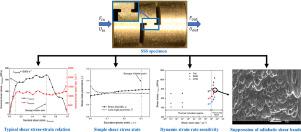International Journal of Impact Engineering ( IF 5.1 ) Pub Date : 2021-04-23 , DOI: 10.1016/j.ijimpeng.2021.103896 B. Jia , A. Rusinek , R. Pesci , R. Bernier , S. Bahi , A. Bendarma , P. Wood

|
A novel single shear specimen (SSS) together with a correction coefficient method is used to study the deformation behavior of a 304 stainless steel under shear loadings. Shear stress-shear strain relations over a wide range of shear strain rates (0.001 to 39000 s−1) at three initial temperatures (77 to 473 K) are obtained experimentally. The effects of strain rate and temperature on the flow stress curves are determined. With increasing strain rate or temperature, the strain hardening rate decreases continuously. At the maximum strain rate of 39000 s−1, negative strain hardening rates are observed. At very high strain rates above 13000 s−1, a sharp increase in flow stress is observed, indicating a rapid rise in strain rate sensitivity. The fracture morphology of post-mortem specimens is analyzed and no well-developed adiabatic shear bands are observed. This may be due to the shear-tension stress state without hydrostatic pressure in the fracture process. Based on the experimentally obtained shear stress-shear strain curves, parameters of a modified Johnson-Cook (MJC) model are determined. A good agreement between experiments and model predictions is found, with an average error of 3.9%. Using finite element analysis, distributions of stress and strain components in the specimen shear zone is analyzed. It is found that the shear stress and shear strain play dominant roles, and a simple shear stress state with low stress triaxiality (0.015) and Lode angle parameter (0.014) is obtained.
中文翻译:

304不锈钢在各种应变速率和温度范围内的简单剪切行为和本构模型
一种新颖的单剪切试样(SSS)以及一种校正系数方法被用于研究304不锈钢在剪切载荷下的变形行为。通过实验获得了在三个初始温度(77至473 K)下,在较大的剪切应变率范围(0.001至39000 s -1)内的剪切应力-剪切应变关系。确定了应变速率和温度对流动应力曲线的影响。随着应变率或温度的升高,应变硬化率不断降低。在39000 s -1的最大应变速率下,观察到负应变硬化速率。在高于13000 s -1的极高应变速率下,观察到流动应力急剧增加,表明应变速率灵敏度迅速提高。分析了尸体标本的断裂形态,没有观察到发育良好的绝热剪切带。这可能是由于断裂过程中没有静水压力的剪应力状态。根据实验获得的剪切应力-剪切应变曲线,确定改进的Johnson-Cook(MJC)模型的参数。实验与模型预测之间找到了很好的一致性,平均误差为3.9%。使用有限元分析,分析了试样剪切带中的应力和应变分量的分布。发现剪应力和剪应变起主要作用,并且具有低三轴应力(0.015)和洛德角参数(0.)的简单剪应力状态。











































 京公网安备 11010802027423号
京公网安备 11010802027423号